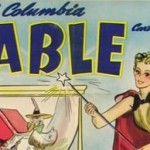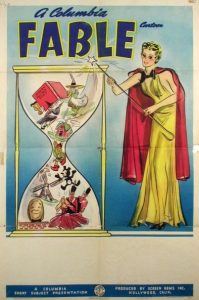


 Unexpected changes had been happening in Columbia cartoons, beginning in 1939 when the studio foreclosed upon Mintz. This action may have had a deleterious effect on Mintz’s health, as he died in early 1940. Soon afterwards, he was joined on his trip to the great beyond by his wife Margaret Winkler, who had started the business back in the silent days. Mintz is not known to have ever put pen to paper, but he must have been more instrumental to his studio than was, for example, Fred Quimby to MGM, as the films seemed to drop considerably in quality following his death. Meanwhile, with all these funerals going on, Columbia continued to pursue the High-Warner style. They also continued to monitor what was popular on the radio, with references to such shows as Baby Snooks and Jack Benny. If Screen Gems had actively tried to syndicate these films in years later, some of them might have been right at home with kid-show hosts of the day. They lacked, however, the one big star that would put them over the top, as far as saleability to television.
Unexpected changes had been happening in Columbia cartoons, beginning in 1939 when the studio foreclosed upon Mintz. This action may have had a deleterious effect on Mintz’s health, as he died in early 1940. Soon afterwards, he was joined on his trip to the great beyond by his wife Margaret Winkler, who had started the business back in the silent days. Mintz is not known to have ever put pen to paper, but he must have been more instrumental to his studio than was, for example, Fred Quimby to MGM, as the films seemed to drop considerably in quality following his death. Meanwhile, with all these funerals going on, Columbia continued to pursue the High-Warner style. They also continued to monitor what was popular on the radio, with references to such shows as Baby Snooks and Jack Benny. If Screen Gems had actively tried to syndicate these films in years later, some of them might have been right at home with kid-show hosts of the day. They lacked, however, the one big star that would put them over the top, as far as saleability to television.
Happy Tots’ Expedition (2/9/40) – A follow-up to The Happy Tots, with a small semblance of plot. An elf astronomer thinks he has spotted the landscape of the planet Mars – which in reality is a city dump. He alerts the king, and a rocket constructed out of a 4th of July firework is launched, taking the king and about half his subjects with it. The rocket gets just far enough to reach the dump, then nose dives, making a safe landing cushioned by an old bedspring. The elves explore the unfamiliar terrain, running afoul of inner tubes, jack-in-the-boxes, and finally an old wind-up Victrola, which proves to be their most fortuitous find, supplying music for an extended production number in the last half of the film. The king finally decides it’s time to go, and relights the rocket for a sputtering return voyage home. This cartoon, even more than its predecessor, seems heavily influenced by a certain seven little men who had recently taken the world by storm at Disney – right down to a grumpy-style elf who constantly complains. Song: an original, with lyrics a bit indistinct, which I believe would be called “Yodel-E-I-Aaa”.
Blackboard Revue (3/15/40) – Midnight in a country school, with characters drawn on the blackboard coming to life. There’s a teacher who takes after Al Pierce’s Tizzie Lish character, who is also totally familiar to Ub Iwerks fans, being the same old crone seen in so many Flip the Frog cartoons, drawn as a stick figure. Familiar voices also appear, with some Mel Blanc and possibly Pinto Colvig. An original song appears, which I’d call, “I’d Like To Be”, in which various student characters illustrate their dreams of their future aspirations. The Rhythmettes provide some vocal in the piece, which enlivens the last half of the cartoon.
Practice Makes Perfect (4/5/40) – Scrappy is practicing the piano. However, he is encountering difficulties with both Oopie and Yippee, including Yippee climbing into the piano, and Oopie’s derisive laughter. Scrappy is trying to practice some classical piece, but winds up playing snatches of “Sing, Baby, Sing”, and other pop tunes. The newcomer is “You’re Slightly Terrific”, from Fox’s Pigskin Parade. Recordings included Tony Martun for Decca, Dick Jurgens for Melotone, Perfect, et al., and Joe Sanders’ Orchestra on Decca.
Tangled Television (8/30/40) – No plot. Three professors (No Squint, No Squat, and No Stoop – a slogan for Philco radio) give a demonstration of experimental television. By that time NBC and CBS were doing experimental broadcasts, in New York, Philadelphia, and Washington D.C. (skipping over Baltimore in-between). The Professors’ experimental apparatus at first lays an egg – literally, but finally produces pictures of a globe-hopping tour, with Mel Blanc providing narration. The finale is lifted footage from “In My Gondola”. Songs: a patter song, “We’re the Professors”, and an imagined art song for a soprano, “Lovely Lover”, both originals.
The Wise Owl (12/6/40) – This Iwerks cartoon does not try to ring the usual changes/tropes of an owl being a font of wisdom. Instead, it deals with an owl as a bird of prey. The owl is trying to rustle up some dinner from the inhabitants of a bat cave. He keeps getting beaten up and expelled by the bats. The owl resorts to more and more elaborate disguises on each attempt, including posing as an Irish tenor, and as Stokowski. At one point, one bat gets locked out, and his knocks at the cave door are mistaken for the owl – so the bat gets beaten up instead. This allows the owl to respond to call from the screen “Is there a doctor in the house?”, approaching the screen from the audience as a shadow, in the disguise of a physician. He almost gets his bat sandwich, but is at last discovered, and carried by the bats to be deposited in the mouth of a geyser, where an eruption lands him back into his own stewpot. Song: “Believe Me If All Those Endearing Young Charms”, for one of the only times in cartoons presented with full lyric in the owl’s Irish tenor disguise. We’ve covered some of the recordings of it before, the most memorable of which was by John McCormack on Victor. Here’s Frank Luther on Decca:
It Happened to Crusoe (3/14.41) – It seems that the staff at Columbia were just as apt to spoof the Jack Benny Program as Warner Brothers. Here, a native chief (voice in imitation of Fred Allen) is berating his son Westchester (impression of Eddie Anderson) over the son’s tendency to favor vegetarian meals over meat. Robinson Crusoe (voiced as Benny) winds up on the island, looking for a new man Friday. Westchester gets the position when Crusoe realizes he’s not a cannibal. Gags taking off on the Benny show abound, including Mel Blanc as the Maxwell. Eventually, a tiger gets involved in it , and Westchester inadvertently comes back to the tribe in glory, providing the tiger as meat on the table. Song: a new untitled jungle jive number, heard at the beginning of the cartoon, which does not appear to be a rehash of Joe De Nat’s old “Umbaa Umbaa”.
There’s Music In Your Hair (3/28/41) – A rather slow-paced musical cartoon, inspired by Leopold Stokowski, recognizable by his long white hair and his disdain for using a baton. A dum-dum violinist takes center stage, with lots of gags being centered around his liking for bubble gum, and being stuck in it for most of the performance. The score appears to be in classical tone, but aside from one little snatch in the credits from Zampa, I am unable to recognize the piece or pieces played. Reader input is invited to identify same, or whether the score is an original.
NEXT TIME: It’s War! 1941 and forward.